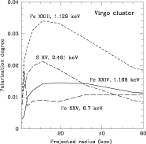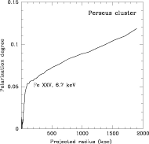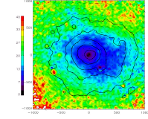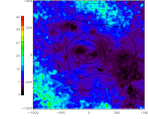|
|  |
Galaxy clusters are the largest gravitationally bound structures in the
Universe. About 80 per cent of their mass is due to dark matter, 15 per
cent due to hot gas and only a few per cent of the mass corresponds to
stars. Hot gas is therefore the dominant baryonic component of clusters
and the largest mass constituent which can be observed directly. Along
the line of sight, the motion of the gas inside the cluster can in
principle be measured by analysing the Doppler shift of X-ray spectral
lines. However, given that the expected shift is very small, X-ray
spectrometers with high spectral resolution are needed. Measuring the
gas motion perpendicular to the line of sight through the usual
spectroscopic techniques is even more difficult, as the shift is about
100 times smaller. We therefore investigated the effects of gas motions
on the polarization in the emitted X-ray light.
The hot gas (107 - 108 K) in galaxy clusters emits X-ray radiation
in a continuum and in emission lines of ionized heavy elements. As iron
is the most abundant element, the resonant lines of ionized iron are
especially strong and bright. In these lines the scattering cross
section is much larger than in the continuum and the optical depth can
be of the order of one or even larger, which means that on average each
photon emitted suffers at least one scattering. For instance, the
optical depth of the iron line at an energy of 6.7 keV in the brightest
clusters in the sky, the Perseus and Virgo clusters, is approximately 3
and 1.4, respectively.
The atomic structure of the ions defines the process of line scattering,
i.e. the absorption and re-emission of a photon, as a combination of
isotropic and Rayleigh scattering. It is well known that the Rayleigh
component leads to a polarization in the emitted radiation (just like in
the case of Thomson scattering) if there is a quadrupole moment in
initial radiation field. In galaxy clusters such a quadrupole moment
arises naturally if either the scattering takes place far from the
bright central core of the cluster and/or if there are gas motions. The
expected degree of polarization is high: in the Perseus cluster it
reaches about 7 per cent in the iron line at 6.7 keV; in the Virgo
cluster it is several per cent in the most promising lines (see Fig. 1).
Transverse gas motions in the cluster can change the expected degree and
direction of the polarization, since the cross section of scattering
along the direction of the motion is decreasing. Using modern, fully three-
dimensional simulations of galaxy clusters we calculated the
polarization degree of the X-ray lines expected when taking gas motions
into account. In Fig. 2 one can see that the polarization degree in the
iron line reaches about 25 per cent within a distance of 500 kpc from
the core if the cluster gas is at rest. Including gas motions decreases
the polarization down to about 10 per cent and causes a rotation of the
polarization plane.
A new era of high resolution X-ray spectroscopy and polarimetric studies
is coming, driven by progress in the development of a new generation of
X-ray detectors. The first polarimetric mission
 GEMS ,
based on the photo-effect principle, is already approved and funded
and will be launched in the near future. Several more missions are
under discussion. Measuring the polarization degree of the bright
X-ray emission lines and comparing these with simulations will provide
us with new information on the bulk and turbulent gas motions in
clusters of galaxies. GEMS ,
based on the photo-effect principle, is already approved and funded
and will be launched in the near future. Several more missions are
under discussion. Measuring the polarization degree of the bright
X-ray emission lines and comparing these with simulations will provide
us with new information on the bulk and turbulent gas motions in
clusters of galaxies.
Irina Zhuravleva, Eugene Churazov, Sergey Sazonov, Rashid Sunyaev, Klaus Dolag
Further Reading:
Zhuravleva I.V., Churazov E.M., Sazonov S.Y., Sunyaev R.A., Forman W., Dolag K.,
'Polarization of X-ray lines from galaxy clusters and elliptical
galaxies - a way to measure the tangential component of gas velocity',
MNRAS, 403, 129—150 (2010)
|



